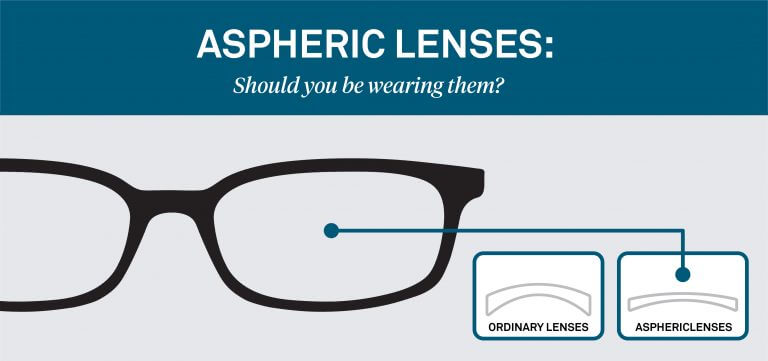A Guide To Aspheric Lenses
When your optometrist prescribes your glasses you are probably thinking more about the frame, its style, its price, and how they are going to look on you and give little thought to the lenses themselves. The optometrist, on the other hand is thinking about your clarity of vision, the weight of the lenses and how they will make your eyes look.
One of the options available is an aspheric lens, these lenses can be particularly beneficial if you have a high prescription, but what are they and why are they so great? Find out all the benefits of aspheric lenses, how they're used and the science behind them
What Is The Difference Between Aspheric Lenses And Regular Lenses?
Traditional lenses, called spherical lenses, possess a uniform curvature across their surface, which often results in certain optical aberrations like distortion and blurring, especially toward the edges of the lens.
Aspheric lenses, on the other hand, deviate from this uniform curvature, adopting a non-spherical curvature. There is a more gradual transition from the centre to the periphery, this variation from sphericity is often too small to be detected by the eye. This design allows for better control over aberrations and image quality, resulting in improved clarity and sharpness of vision.

Design And Benefits
The key to the superiority of aspheric lenses lies in their complex design. Instead of having a single radius of curvature, these lenses exhibit a varying curvature across their surface, meticulously calculated to counteract aberrations. This design enables aspheric lenses to focus light rays more precisely onto a single point, enhancing image quality across the entire visual field.
What Are The Benefits Of Aspheric Lenses?
- Reduced Aberrations: By minimising optical aberrations such as spherical aberration, coma, and distortion, aspheric lenses provide clearer images with improved contrast and sharpness.
- Thinner and Lighter: Due to their optimised curvature, aspheric lenses can achieve the same optical performance as traditional spherical lenses with fewer layers of material, resulting in thinner and lighter lenses, making them ideal for eyeglasses.
- Sleeker Profile: There is less bulging of the lenses, providing a wider choice of frames for people with higher prescriptions.
- A more Natural Look: Aspheric lenses can reduce the amount of magnification that regular lenses can create for people with high prescriptions of Hypermetropia and reduce the effect of small eyes that can occur in high levels of Myopia.
- Better Peripheral Vision: Aspheric lenses maintain better optical performance across a wider field of view, allowing users to enjoy distortion-free images even at the edges of the lens.
- Light Weight: Aspheric lenses use less material than regular lenses, making them lighter
- Enhanced Aesthetics: In photography and cinematography, aspheric lenses are prized for their ability to produce more natural and pleasing images, reducing the "bulging" effect often seen in wide-angle shots.
- Compact Optical Devices: Aspheric lenses enable the creation of smaller and more compact optical devices without sacrificing optical quality, making them indispensable in the design of medical instruments, cameras and smartphones.
Applications Of Aspheric Lenses
- Glasses: Aspheric lenses have revolutionised the eyewear industry by providing wearers with thinner and lighter lenses that offer improved visual clarity. These lenses are particularly beneficial for those with higher prescriptions, as they reduce the "bug-eye" effect commonly associated with thick lenses.
- Contact Lenses: Aspheric contact lenses also have a varying curvature across their surface, which changes from the centre of the lens to the edge. This minimises the optical aberrations within the human eye that can be caused by the tear film, cornea and the crystalline lens, so are able to offer clear, crisp and sharp vision
- Photography and Cinematography: Professional photographers and filmmakers value the distortion-free and high-resolution imagery that aspheric lenses can deliver. These lenses help capture intricate details and maintain image quality across the entire frame, making them a staple in the world of visual arts.
- Medical Devices: Aspheric lenses are crucial in medical imaging devices like endoscopes and microscopes, where precision and clarity are of utmost importance. These lenses enable medical professionals to visualise and diagnose conditions more accurately.
- Telescopes and Microscopes: In the realm of scientific research, aspheric lenses play a pivotal role in telescopes and microscopes, allowing researchers to observe celestial bodies and microscopic structures with greater clarity.
Aspheric lenses play an important role in optics from medical devices, cameras, and telescopes to glasses and contact lenses. If you are looking for a slim, light weight pair of glasses that can enhance your vision and the aesthetics of your glasses, then speak to your optometrist about aspheric lenses, that's if they haven't mentioned them first.
Author: John Dreyer Optometrist Bsc(Hons), MCOPTOM, DipCLP
Created: 8 Sep 2023, Last modified: 7 Jan 2025

